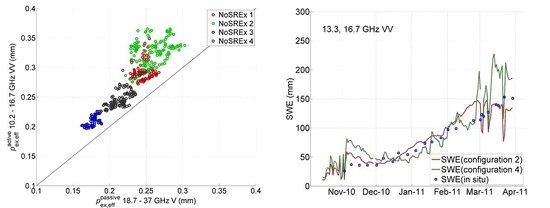Retrieval of Effective Correlation Length and Snow Water Equivalent from Radar and Passive Microwave Measurements
Abstract
:1. Introduction
- Retrieve an effective snow correlation length by matching emission and backscattering model predictions to the radiometer and radar measurements, respectively. Examine the seasonal behavior in the observed changes and relate these to physical properties of the snowpack
- Examine the interchangeability of the active and passive microwave effective correlation length, and determine the sensitivity of these estimates to observation frequency and polarization.
- Apply an effective correlation length derived from one sensor type (passive) to initialize the retrieval of SWE using the other (active). Compare the impact on SWE retrievals of applying temporally dynamic effective correlation length versus a seasonally constant value, optimized separately for each winter season.
2. Forward Model and Retrieval Method
2.1. MEMLS3&a Model
2.2. Retrieval of Effective Correlation Length
2.3. Retrieval of SWE
- Configuration 1: An overall average of optimized daily values <pactiveex,eff> was calculated from all retrievals of pactiveex,eff under dry snow conditions for all four seasons. Averages were calculated separately for each channel and combination. These average values of optimizations were used to initialize the respective retrievals of SWE at time t (pex,eff (t) = <pactiveex,eff>).
- Configuration 2: As in Configuration 1, but the average of optimized daily values <pactiveex,eff> was calculated and applied in SWE retrieval individually for each of the four winter seasons, thus applying seasonal optimization to the retrieval.
- Configuration 3: For each radar retrieval of SWE at time t, the effective correlation length was acquired from the temporally closest passive microwave retrieval (pex,eff (t) = ppassiveex,eff (t)). As a default, ppassiveex,eff was obtained from 18.7–37 GHz, V-pol, radiometer retrievals.
- Configuration 4: As in Configuration 3, but the value of ppassiveex,eff was scaled so that pex,eff (t) = β ppassiveex,eff (t). A constant scaling value β was applied in SWE retrieval across all seasons.
3. The NoSREx Campaign
3.1. Microwave Observations
3.2. In Situ Data
3.3. Campaign Summary
4. Results
4.1. Retrieved Active and Passive Correlation Length
4.2. SWE Retrieval Using Radar Observations
5. Discussion
6. Conclusions
Acknowledgments
Author Contributions
Conflicts of Interest
References
- Mudryk, L.R.; Derksen, C.; Kushner, P.J.; Brown, R. Characterization of Northern Hemisphere snow water equivalent datasets, 1981–2010. J. Clim. 2015, 28, 8037–8051. [Google Scholar] [CrossRef]
- Larue, F.; Royer, A.; De Sève, D.; Langlois, A.; Roy, A.; Brucker, L. Validation analysis of the GlobSnow-2 database over an eco-climatic latitudinal gradient in Eastern Canada. Remote Sens. Environ. 2016, 194, 264–277. [Google Scholar] [CrossRef]
- Kelly, R.E.J. The AMSR-E Snow depth algorithm: Description and initial results. J. Remote Sens. Soc. Jpn. 2009, 29, 307–317. [Google Scholar]
- Takala, M.; Luojus, K.; Pulliainen, J.; Derksen, C.; Lemmetyinen, J.; Kärnä, J.-P.; Koskinen, J.; Bojkov, B. Estimating northern hemisphere snow water equivalent for climate research through assimilation of space-borne radiometer data and ground-based measurements. Remote Sens. Environ. 2011, 115, 3517–3529. [Google Scholar] [CrossRef]
- Painter, T.H.; Berisford, D.F.; Boardman, J.W.; Bormann, K.J.; Deems, J.S.; Gehrke, F.; Hedrick, A.; Joyce, M.; Laidlaw, R.; Marks, D.; et al. The Airborne Snow Observatory: Fusion of scanning LiDAR, imaging spectrometer, and physically-based modeling for mapping snow water equivalent and snow albedo. Remote Sens. Environ. 2016, 184, 139–152. [Google Scholar] [CrossRef]
- Foster, J.; Sun, C.; Walker, J.; Kelly, R.; Chang, A.; Dong, J.; Powell, H. Quantifying uncertainty in passive microwave snow water equivalent observations. Remote Sens. Environ. 2005, 94, 187–203. [Google Scholar] [CrossRef]
- Clifford, D. Global estimates of snow water equivalent from passive microwave instruments: History, challenges and future developments. Int. J. Remote Sens. 2010, 31, 3707–3726. [Google Scholar] [CrossRef]
- Rott, H.; Yueh, S.H.; Cline, D.W.; Duguay, C.; Essery, R.; Haas, C.; Hélière, F.; Kern, M.; Macelloni, G.; Malnes, E.; et al. Cold regions hydrology high-resolution observatory for snow and cold land processes. Proc. IEEE 2010, 98, 752–765. [Google Scholar] [CrossRef] [Green Version]
- Dai, L.Y.; Che, T.; Wang, J.; Zhang, P. Snow depth and snow water equivalent estimation from AMSR-E data based on a priori snow characteristics in Xinjiang, China. Remote Sens. Environ. 2012, 127, 14–29. [Google Scholar] [CrossRef]
- Davenport, I.J.; Sandells, M.J.; Gurney, R.J. The effects of variation in snow properties on passive microwave snow mass estimation. Remote Sens. Environ. 2012, 118, 168–175. [Google Scholar] [CrossRef]
- Durand, M.; Liu, D. The need for prior information in characterizing snow water equivalent from microwave brightness temperatures. Remote Sens. Environ. 2012, 126, 248–257. [Google Scholar] [CrossRef]
- Fierz, C.; Armstrong, R.L.; Durand, Y.; Etchevers, P.; Greene, E.; McClung, D.M.; Nishimura, K.; Satyawali, P.K.; Sokratov, S.A. The International Classification for Seasonal Snow on the Ground; IACS Contribution no. 1; UNESCOIHP, I HP-VII Technical Documents in Hydrology 83; UNESCO: Paris, France, 2009. [Google Scholar]
- Hallikainen, M.T.; Ulaby, F.; Deventer, T. Extinction behavior of dry snow in the 18- to 90-GHz range. IEEE Trans. Geosci. Remote Sens. 1987, GE-25, 737–745. [Google Scholar] [CrossRef]
- Pulliainen, J.T.; Grandell, J.; Hallikainen, M.T. HUT snow emission model and its applicability to snow water equivalent retrieval. IEEE Trans. Geosci. Remote Sens. 1999, 37, 1378–1390. [Google Scholar] [CrossRef]
- Pulliainen, J. Mapping of snow water equivalent and snow depth in boreal and sub-arctic zones by assimilating space-borne microwave radiometer data and ground-based observations. Remote Sens. Environ. 2006, 101, 257–269. [Google Scholar] [CrossRef]
- Lemmetyinen, J.; Derksen, C.; Toose, P.; Proksch, M.; Pulliainen, J.; Kontu, A.; Rautiainen, K.; Seppänen, J.; Hallikainen, M. Simulating seasonally and spatially varying snow cover brightness temperature using HUT snow emission model and retrieval of a microwave effective grain size. Remote Sens. Environ. 2015, 156, 71–95. [Google Scholar] [CrossRef]
- Kelly, R.; Chang, A.; Tsang, L.; Foster, J. A prototype AMSR-E global snow area and snow depth algorithm. IEEE Trans. Geosci. Remote Sens. 2003, 41, 230–242. [Google Scholar] [CrossRef]
- Pinzer, B.; Schneebeli, M. Snow metamorphism under alternating temperature gradients: Morphology and recrystallization in surface snow. Geophys. Res. Lett. 2009, 36, L23503. [Google Scholar] [CrossRef]
- Pinzer, B.; Schneebeli, M.; Kaempfer, T. Vapor flux and recrystallization during dry snow metamorphism under a steady temperature gradient as observed by time-lapse micro-tomography. Cryosphere 2012, 6, 1141–1155. [Google Scholar] [CrossRef] [Green Version]
- Tsang, L.; Chen, C.-T.; Chang, A.T.C.; Guo, J.; Ding, K.-H. Dense media radiative transfer theory based on quasi-crystalline approximation with applications to microwave remote sensing of snow. Radio Sci. 2000, 35, 731–749. [Google Scholar] [CrossRef]
- Tsang, L.; Pan, J.; Liand, D.; Li, Z.; Cline, D.W.; Tan, Y. Modeling active microwave remote sensing of snow using dense medium radiative transfer (DMRT) theory with multiple-scattering effects. IEEE Trans. Geosci. Remote Sens. 2007, 45, 990–1004. [Google Scholar] [CrossRef]
- Picard, G.; Brucker, L.; Roy, A.; Dupont, F.; Fily, M.; Royer, A. Simulation of the microwave emission of multi-layered snowpacks using the dense media radiative transfer theory: The DMRT-ML model. Geosci. Model Devel. 2013, 6, 1061–1078. [Google Scholar] [CrossRef]
- Löwe, H.; Picard, G. Microwave scattering coefficient of snow in MEMLS and DMRT-ML revisited: The relevance of sticky hard spheres and tomography-based estimates of stickiness. Cryosphere 2015, 9, 2101–2117. [Google Scholar] [CrossRef] [Green Version]
- Tan, S.; Chang, W.; Tsang, L.; Lemmetyinen, J.; Proksch, M. Modeling both active and passive microwave remote sensing of snow using dense media radiative transfer (DMRT) theory with multiple scattering and backscattering enhancement. IEEE J. Sel. Top. Appl. Earth Obs. Remote Sens. 2015, 8, 4418–4430. [Google Scholar] [CrossRef]
- Mätzler, C. Relation between grain-size and correlation length of snow. J. Glaciol. 2002, 162, 461–466. [Google Scholar] [CrossRef]
- Derksen, C.; Lemmetyinen, J.; King, J.; Garnaud, C.; Belair, S.; Lapointe, M.; Crevier, Y.; Girard, R.; Burbidge, G.; Marquez-Martinez, J.; et al. A new dual-frequency Ku-band radar mission concept for cryosphere applications. Proc. EUSAR 2018. submitted. [Google Scholar]
- Lemmetyinen, J.; Kontu, A.; Pulliainen, J.; Vehviläinen, J.; Rautiainen, K.; Wiesmann, A.; Mätzler, C.; Werner, C.; Rott, H.; Nagler, T.; et al. Nordic snow radar experiment. Geosci. Instrum. Methods Data Syst. 2016, 5, 403–415. [Google Scholar] [CrossRef]
- Wiesmann, A.; Mätzler, C. Microwave emission model of layered snowpacks. Remote Sens. Environ. 1999, 70, 307–316. [Google Scholar] [CrossRef]
- Mätzler, C.; Wiesmann, A. Extension of the microwave emission model of layered snowpacks to coarse grained snow. Remote Sens. Environ. 1999, 70, 318–326. [Google Scholar] [CrossRef]
- Proksch, M.; Mätzler, C.; Wiesmann, A.; Lemmetyinen, J.; Schwank, M.; Löwe, H.; Schneebeli, M. MEMLS3&a: Microwave emission model of layered snowpacks adapted to include backscattering. Geosci. Model Dev. 2015, 8, 2611–2626. [Google Scholar] [CrossRef]
- Wegmüller, U.; Mätzler, C. Rough bare soil reflectivity model. IEEE Trans. Geosci. Remote Sens. 1999, 37, 1391–1395. [Google Scholar] [CrossRef]
- Pulliainen, J.; Kärnä, J.-P.; Hallikainen, M.T. Development of geophysical retrieval algorithms for the MIMR. IEEE Trans. Geosci. Remote Sens. 1993, 31, 268–277. [Google Scholar] [CrossRef]
- Sturm, M.; Taras, B.; Liston, G.E.; Derksen, C.; Jonas, T.; Lea, J. Estimating snow water equivalent using snow depth data and climate classes. J. Hydrometeorol. 2010, 11, 1380–1394. [Google Scholar] [CrossRef]
- Hallikainen, M.T.; Ulaby, F.T.; Dobson, M.C.; El-Rayes, M.A.; Wu, L.-K. Microwave dielectric behavior of wet Soil—Part I: Empirical models and experimental observations. IEEE Trans. Geosci. Remote Sens. 1985, 23, 25–33. [Google Scholar] [CrossRef]
- Gallet, J.-C.; Domine, F.; Zender, C.; Picard, G. Measurement of the specific surface area of snow using infrared reflectance in an integrating sphere at 1310 and 1550 nm. Cryosphere 2009, 3, 167–182. [Google Scholar] [CrossRef] [Green Version]
- Leppänen, L.; Kontu, A.; Vehviläinen, J.; Lemmetyinen, J.; Pulliainen, J. Comparison of traditional and optical grain size field measurements with SNOWPACK simulations in a taiga environment. J. Glaciol. 2015, 61, 151–162. [Google Scholar] [CrossRef]
- Schneebeli, M.; Pielmeier, C.; Johnson, J.B. Measuring snow microstructure and hardness using a high resolution penetrometer. Cold Reg. Sci. Technol. 1999, 30, 101–114. [Google Scholar] [CrossRef]
- Proksch, M.; Löwe, H.; Schneebeli, M. Density, specific surface area, and correlation length of snow measured by high-resolution penetrometry. J. Geophys. Res. Earth Surf. 2015, 120, 346–362. [Google Scholar] [CrossRef]
- Leppänen, L.; Kontu, A.; Hannula, H.-R.; Sjöblom, H.; Pulliainen, J. Sodankylä manual snow survey program. Geosci. Inst. Methods Data Syst. Discuss. 2016, 5, 163–179. [Google Scholar] [CrossRef]
- Paloscia, S.; Pettinato, S.; Santi, E.; Valt, M. COSMO-SkyMed image investigation of snow features in alpine environment. Sensors 2017, 17, 84. [Google Scholar] [CrossRef] [PubMed]
- Brucker, L.; Royer, A.; Picard, G.; Langlois, A.; Fily, M. Hourly simulations of the microwave brightness temperature of seasonal snow in Quebec, Canada, using a coupled snow evolution-emission model. Remote Sens. Environ. 2011, 115, 1966–1977. [Google Scholar] [CrossRef]
- Lin, C.; Rommen, B.; Floury, N.; Schûttemeyer, D.; Davidson, M.W.; Kern, M.; Kontu, A.; Lemmetyinen, J.; Pulliainen, J.; Wiesmann, A.; et al. Active Microwave Scattering Signature of Snowpack-Continuous Multiyear SnowScat Observation Experiments. IEEE J. Sel. Top. Appl. Earth Obs. Remote Sens. 2016, 9, 3849–3869. [Google Scholar] [CrossRef]
- Cohen, J.; Lemmetyinen, J.; Pulliainen, J.; Heinilä, K.; Montomoli, F.; Seppänen, J.; Hallikainen, M.T. The effect of boreal forest canopy in satellite snow mapping—A multisensor analysis. IEEE Trans. Geosci. Remote Sens. 2015, 52, 3275–3288. [Google Scholar] [CrossRef]
- King, J.; Derksen, C.; Toose, P.; Langlois, A.; Larsen, C.; Lemmetyinen, J.; Marsh, J.; Montpetit, B.; Roy, A.; Rutter, N.; et al. The influence of snow microstructure on dual-frequency radar measurements in a tundra environment. Remote Sens. Environ. 2018. submitted. [Google Scholar]
- Cui, Y.; Xiong, C.; Lemmetyinen, J.; Shi, J.; Jiang, L.; Peng, B.; Li, H.; Zhao, T.; Ji, D.; Hu, T. Estimating Snow Water Equivalent with backscattering at X and Ku band based on absorption loss. Remote Sens. 2016, 8, 505. [Google Scholar] [CrossRef]
- Kontu, A.; Lemmetyinen, J.; Vehviläinen, J.; Leppänen, L.; Pulliainen, J. Coupling SNOWPACK-modeled grain size parameters with the HUT snow emission model. Remote Sens. Environ. 2017, 194, 33–47. [Google Scholar] [CrossRef]
- Sandells, M.; Essery, R.; Rutter, N.; Wake, L.; Leppänen, L.; Lemmetyinen, J. Microstructure representation of snow in coupled snowpack and microwave emission models. Cryosphere 2017, 11, 229–246. [Google Scholar] [CrossRef]
- Langlois, A.; Royer, A.; Derksen, C.; Montpetit, B.; Dupont, F.; Goïta, K. Coupling the snow thermodynamic model SNOWPACK with the microwave emission model of layered snowpacks for subarctic and arctic snow water equivalent retrievals. Water Resour. Res. 2012, 48, 1–14. [Google Scholar] [CrossRef]
- Picard, G.; Brucker, L.; Fily, M.; Gallée, H.; Krinner, G. Modelling time series of microwave brightness temperature in Antarctica. J. Glaciol. 2009, 55, 537–551. [Google Scholar] [CrossRef]
- De Lannoy, G.J.M.; Reichle, R.H.; Houser, P.R.; Arsenault, K.R.; Verhoest, N.E.C.; Pauwels, V.N.R. Satellite-scale snow water equivalent assimilation into a high-resolution land surface model. J. Hydrometeorol. 2010, 11, 352–369. [Google Scholar] [CrossRef]
- Durand, M.; Kim, E.J.; Marguilis, S.A. Radiance assimilation shows promise for snowpack characterization. Geophys. Res. Lett. 2009, 36, L02503. [Google Scholar] [CrossRef]
- Kwon, Y.; Yang, Z.-L.; Hoar, T.J.; Toure, A.M. Improving the radiance assimilation performance in estimating snow water storage across snow and land-cover types in North America. J. Hydrometeorol. 2017, 18, 651–668. [Google Scholar] [CrossRef]
- Andreadis, K.M.; Lettenmaier, D.P. Implications of representing snowpack stratigraphy for the assimilation of passive microwave satellite observations. J. Hydrometeorol. 2012, 13, 1493–1506. [Google Scholar] [CrossRef]
- Roy, A.; Royer, A.; Montpetit, B.; Bartlett, P.A.; Langlois, A. Snow specific surface area simulation using the one-layer snow model in the Canadian LAnd Surface Scheme (CLASS). Cryosphere 2013, 7, 961–975. [Google Scholar] [CrossRef]
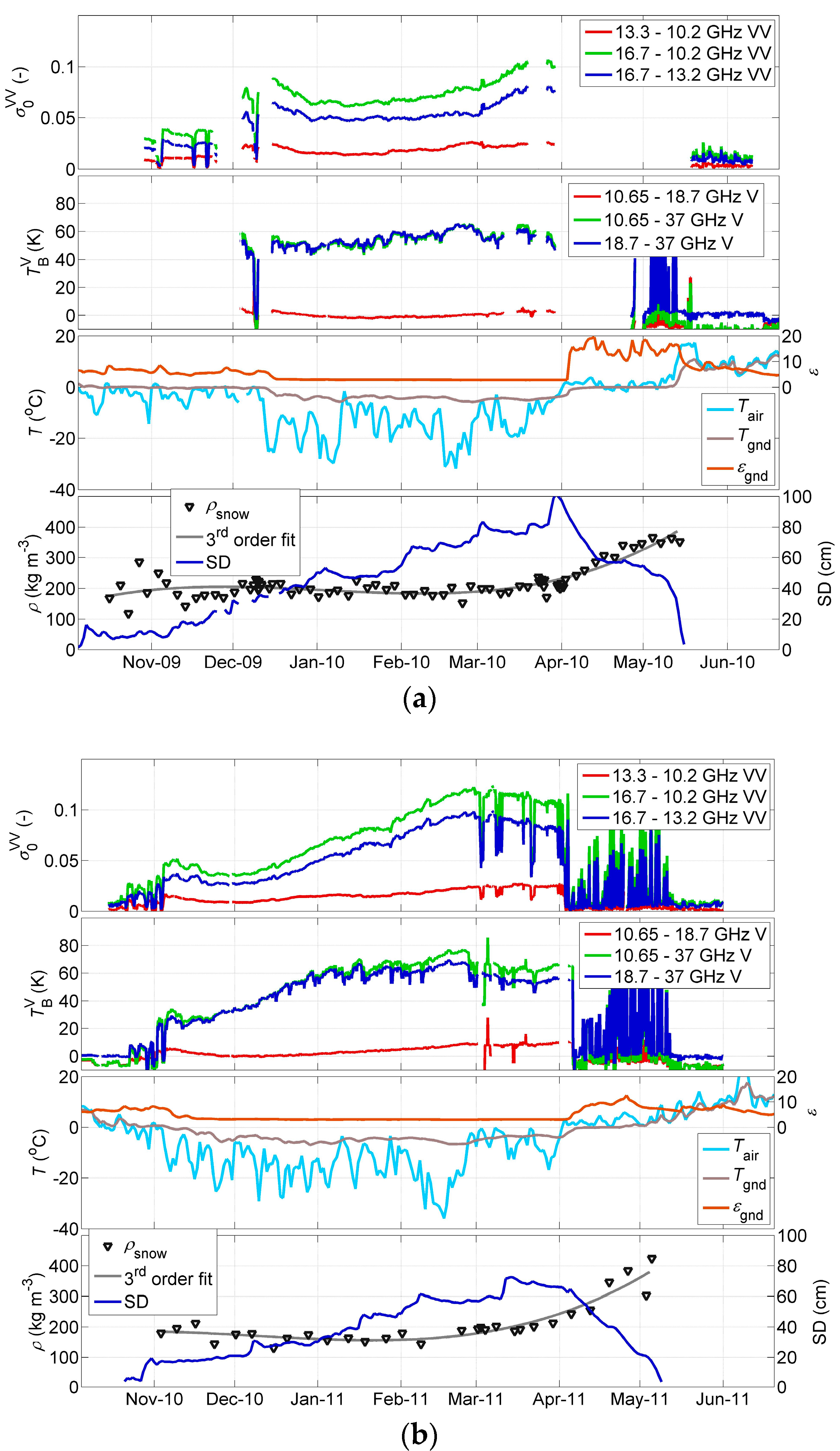
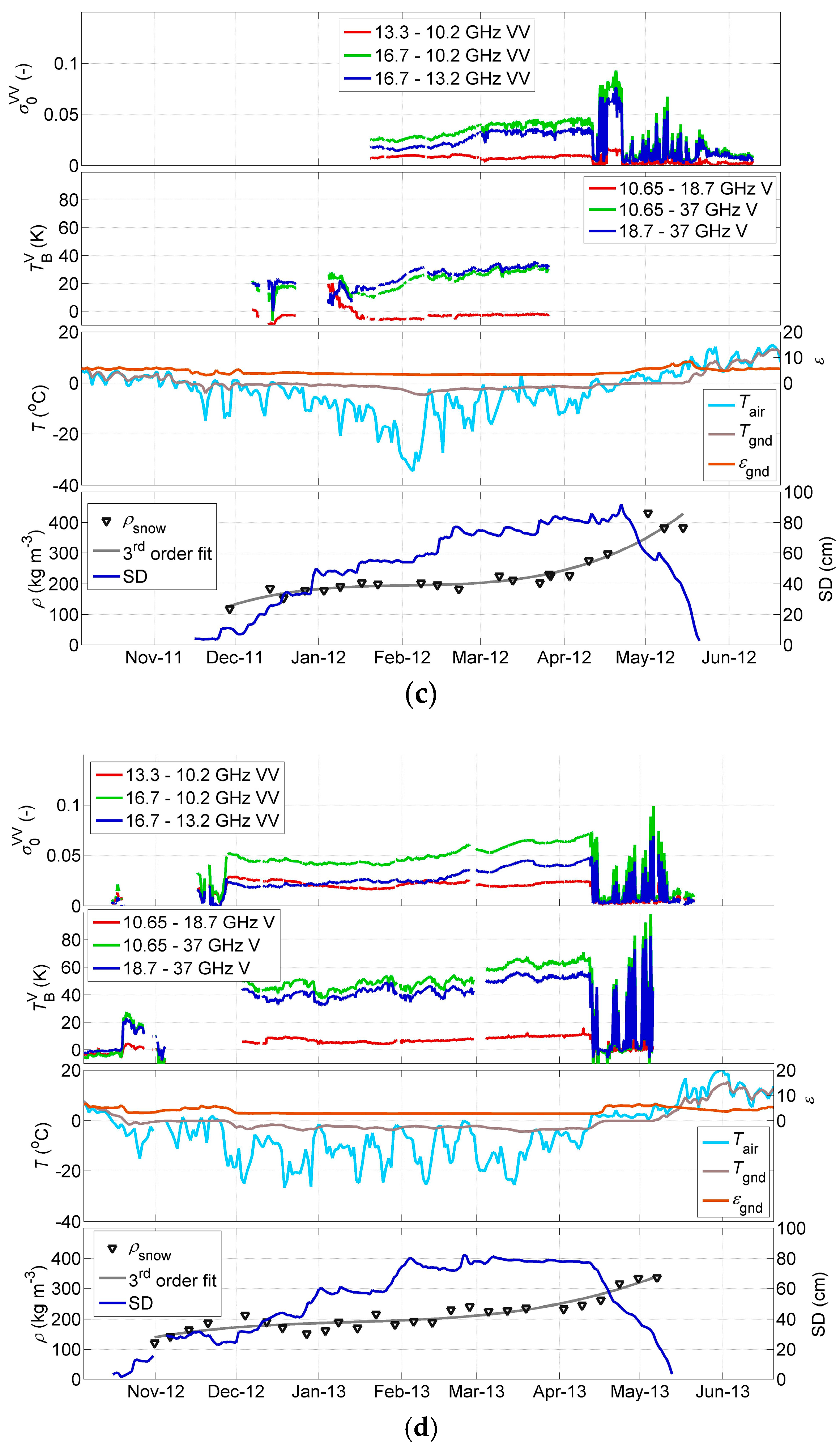
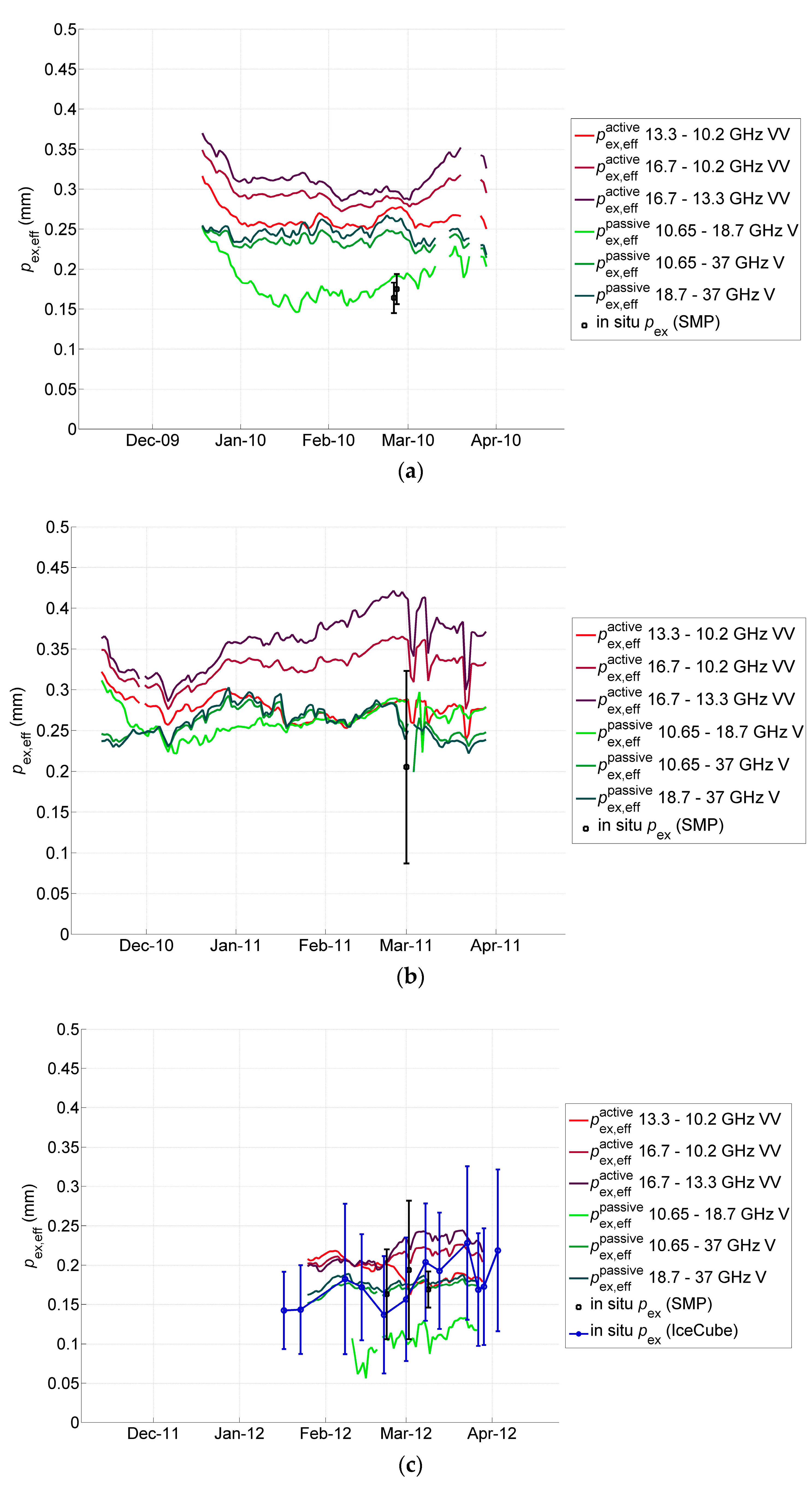


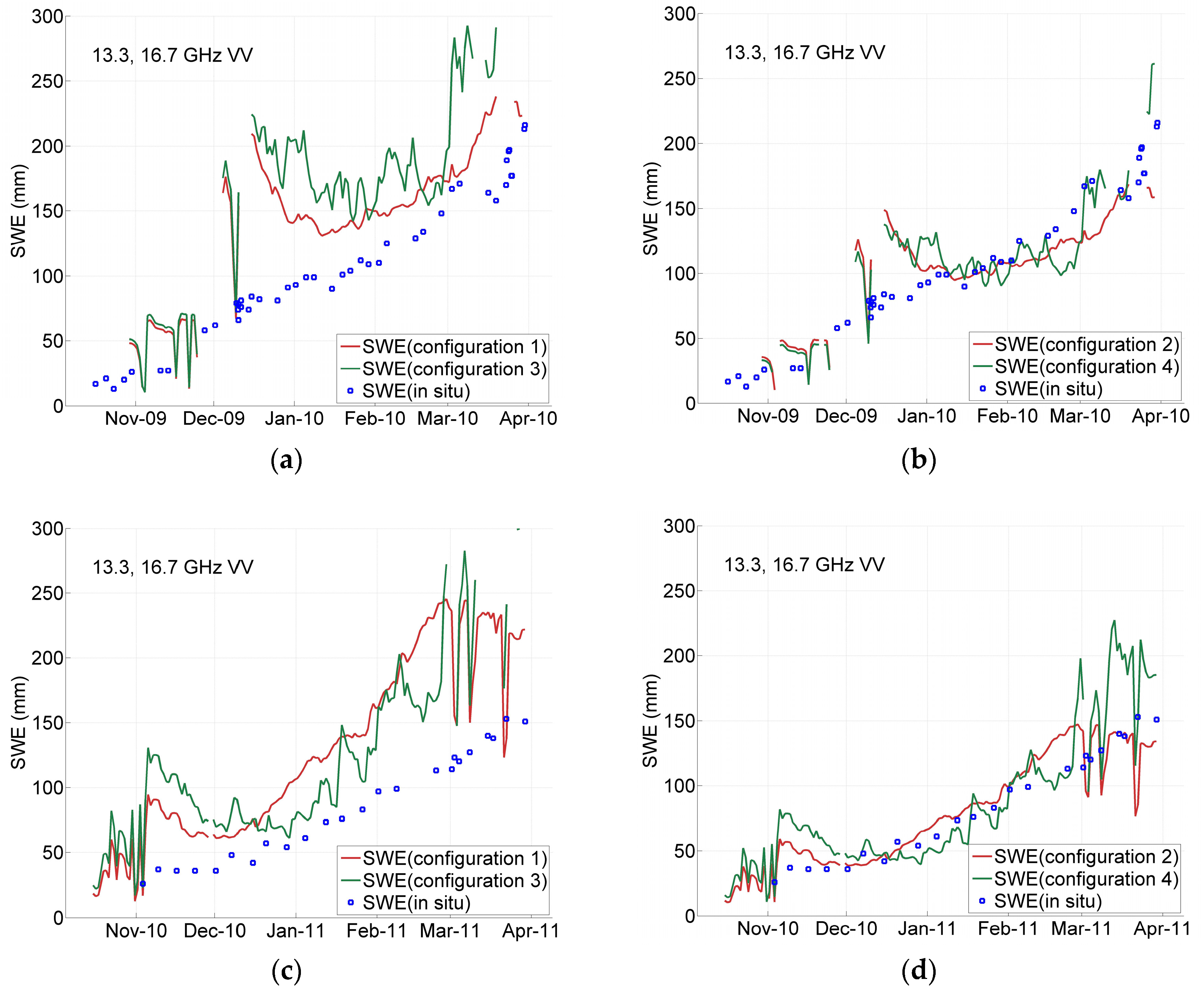
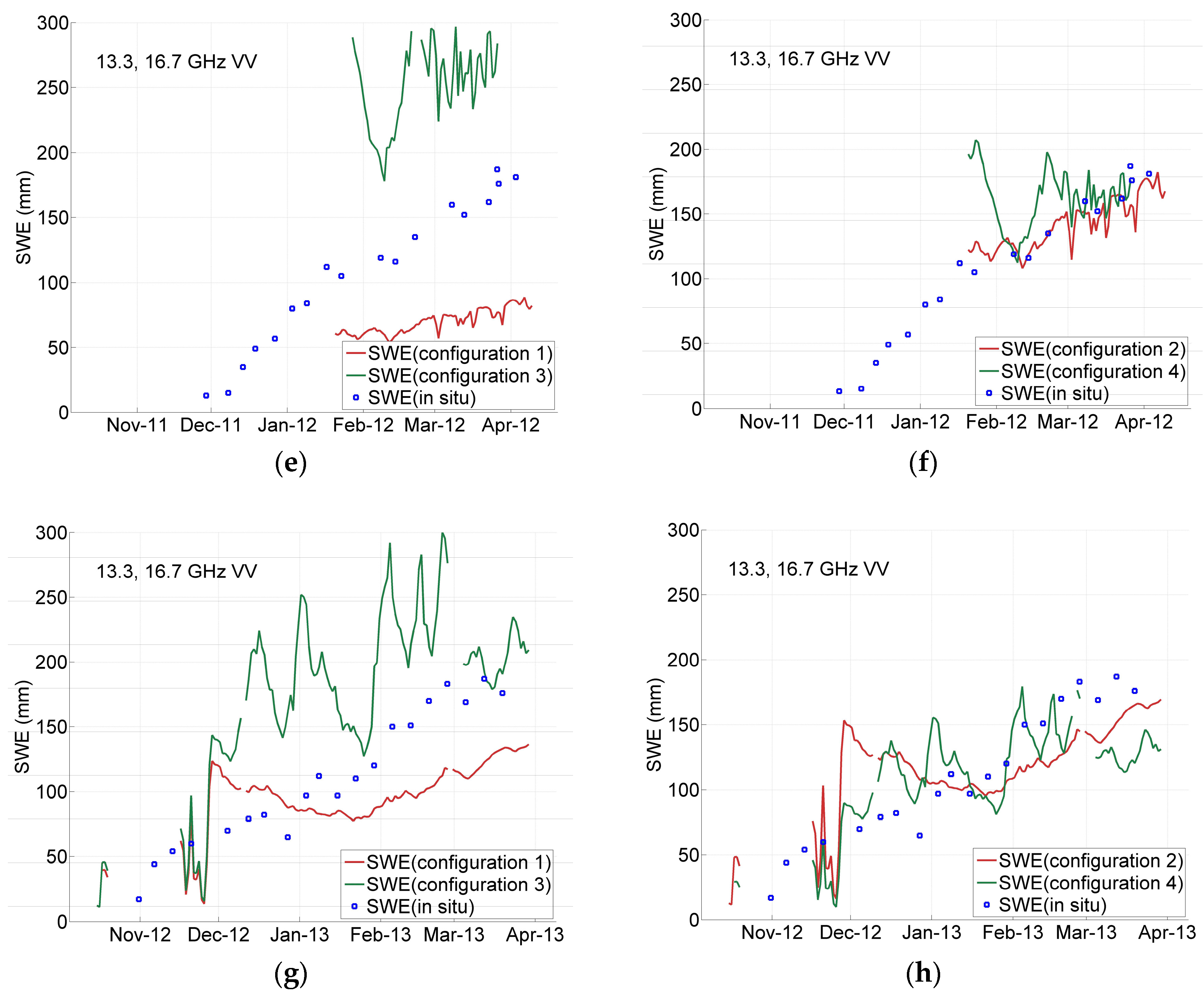


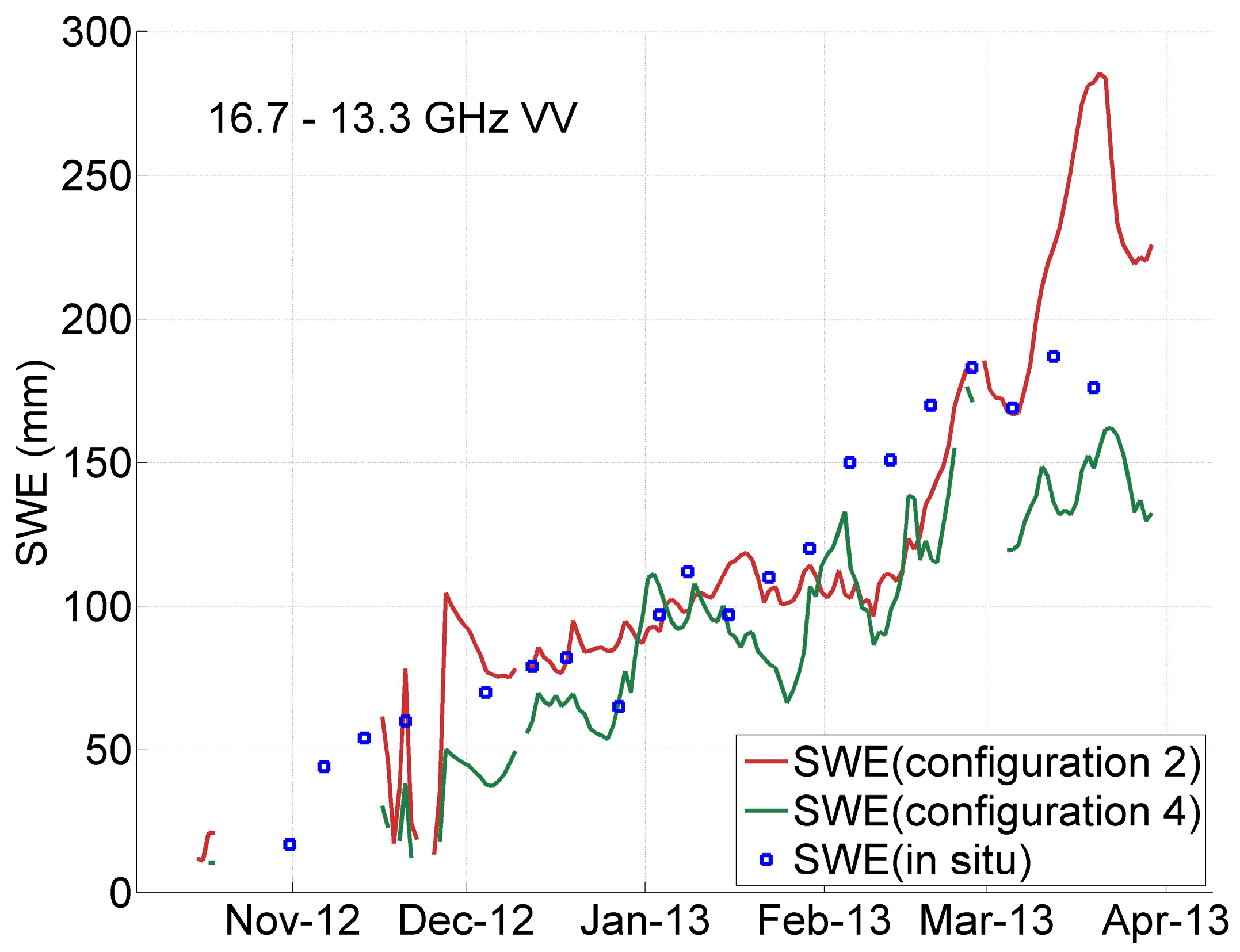
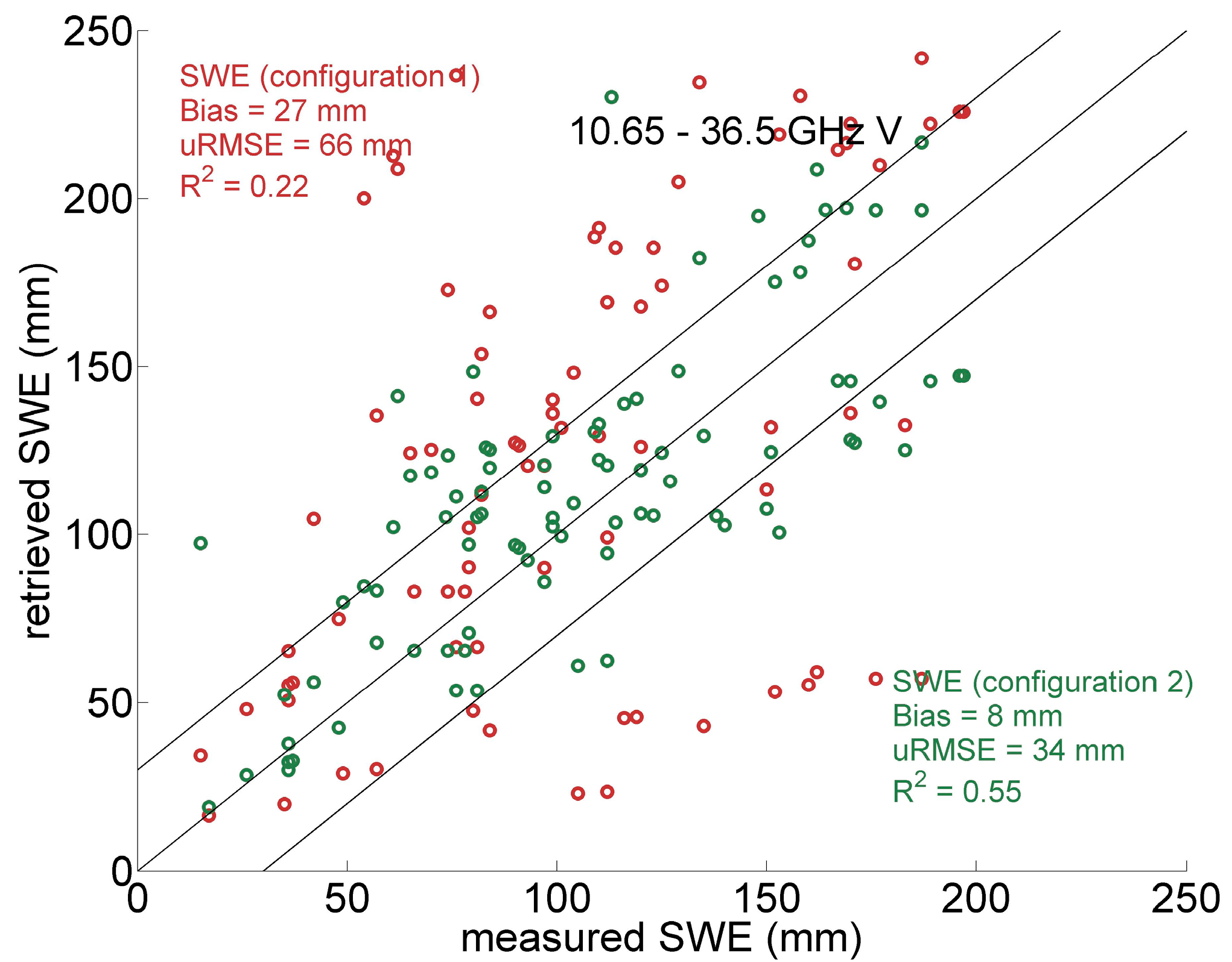
| Parameter | Description | Value |
|---|---|---|
| F | Centre frequency | active: 10.2, 13.3, 16.7 GHz passive: 18.7, 37 GHz |
| θk | Incidence angle | 50° |
| s0v | V-pol reflectivity of snow-ground interface | 0.03(@37 GHz)…0.06(@10.2 GHz) using εgnd = 4 and hrms = 1 cm [31] |
| s0h | H-pol reflectivity of snow-ground interface | 0.05(@37 GHz)…0.07(@10.2 GHz) using εgnd = 4 and hrms = 1 cm [31] |
| ss0v, ss0h | Specular part of reflectivity | 0.9 |
| q | Fraction of cross-polarized scattering | (cross polarization not used) |
| Tsky | Downwelling sky brightness temperature | 5 (@10.2 GHz) to 35 K (@37 GHz) [32] |
| Tgnd | Ground temperature | −5 °C |
| Tsnow | Snow temperature | −5 °C |
| ρsnow | Snow density | 200 kg m−3 |
| Scattering model | IBA | |
| Number of layers | 1 | |
| R2 | 10.2 GHz | 13.3 GHz | 16.7 GHz | 10.2 & 13.3 GHz | 10.2 & 16.7 GHz | 13.3 & 16.7 GHz | 13.3–10.2 GHz | 16.7–10.2 GHz | 16.7–13.3 GHz |
|---|---|---|---|---|---|---|---|---|---|
| 10.65 GHz | 0.07 (0.11) | 0.13 (0.07) | 0.00 (0.20) | 0.12 (0.08) | 0.00 (0.21) | 0.00 (0.20) | 0.15 (0.01) | 0.01 (0.15) | 0.03 * (0.17) |
| 18.7 GHz | 0.00 (0.08) | 0.10 (0.39) | 0.04 (0.02) | 0.07 (0.35) | 0.04 (0.03) | 0.02 (0.06) * | 0.27 (0.53) | 0.04 (0.01) | 0.10 (0.01) |
| 37 GHz | 0.00 (0.09) | 0.40 (0.47) | 0.74 (0.79) | 0.33 (0.41) | 0.73 (0.79) | 0.75 (0.80) | 0.59 (0.65) | 0.74 (0.79) | 0.59 (0.63) |
| 10.65 & 18.7 GHz | 0.01 (0.09) | 0.13 * (0.41) | 0.03 (0.03) | 0.10 (0.37) | 0.03 * (0.03) | 0.01 * (0.06) * | 0.29 (0.53) | 0.04 (0.02) | 0.10 (0.01) |
| 10.65 & 37 GHz | 0.00 (0.04) | 0.40 (0.47) | 0.73 (0.79) | 0.33 (0.41) | 0.73 (0.78) | 0.75 (0.80) | 0.59 (0.65) | 0.74 (0.79) | 0.58 (0.63) |
| 18.7 & 37 GHz | 0.00 (0.04) | 0.42 (0.49) | 0.72 (0.77) | 0.34 (0.42) | 0.72 (0.77) | 0.74 (0.79) | 0.62 (0.68) | 0.73 (0.78) | 0.56 (0.61) |
| 10.65–18.7 GHz | 0.03 (0.05) | 0.27 (0.10) | 0.19 (0.07) | 0.19 (0.05) | 0.19 (0.06) | 0.23 (0.08) | 0.62 (0.40) | 0.23 (0.09) | 0.09 (0.02) |
| 10.65–37 GHz | 0.01 (0.01) | 0.34 (0.38) | 0.74 (0.79) | 0.27 (0.32) | 0.74 (0.78) | 0.75 (0.78) | 0.59 (0.60) | 0.78 (0.82) | 0.62 (0.68) |
| 18.7–37 GHz | 0.00 (0.02) | 0.29 (0.34) | 0.78 (0.82) | 0.24 (0.29) | 0.78 (0.82) | 0.77 (0.80) | 0.44 (0.47) | 0.79 (0.84) | 0.69 (0.76) |
| Season | 10.2 GHz | 13.3 GHz | 16.7 GHz | 10.2 & 13.3 GHz | 10.2 & 16.7 GHz | 13.3 & 16.7 GHz | 13.3–10.2 GHz | 16.7–10.2 GHz | 16.7–13.3 GHz |
|---|---|---|---|---|---|---|---|---|---|
| NoSREx 1 | 0.28 | 0.27 | 0.29 | 0.27 | 0.29 | 0.29 | 0.26 | 0.29 | 0.31 |
| NoSREx 2 | 0.21 | 0.26 | 0.31 | 0.25 | 0.31 | 0.30 | 0.28 | 0.33 | 0.36 |
| NoSREx 3 | 0.23 | 0.21 | 0.21 | 0.21 | 0.21 | 0.21 | 0.19 | 0.21 | 0.22 |
| NoSREx 4 | 0.23 | 0.25 | 0.24 | 0.25 | 0.24 | 0.25 | 0.27 | 0.25 | 0.23 |
| Season | 10.65 GHz | 18.7 GHz | 37 GHz | 10.65 & 18.7 GHz | 10.65 & 37 GHz | 18.7 & 37 GHz | 10.65–18.7 GHz | 10.65–37 GHz | 18.7–37 GHz |
|---|---|---|---|---|---|---|---|---|---|
| NoSREx 1 | 0.25 | 0.16 | 0.23 | 0.17 | 0.23 | 0.23 | 0.18 | 0.24 | 0.25 |
| NoSREx 2 | 0.31 | 0.18 | 0.24 | 0.18 | 0.24 | 0.24 | 0.26 | 0.26 | 0.26 |
| NoSREx 3 | - | - | 0.17 | - | 0.17 | 0.16 | 0.11 | 0.17 | 0.18 |
| NoSREx 4 | 0.34 | 0.22 | 0.22 | 0.22 | 0.22 | 0.22 | 0.27 | 0.23 | 0.22 |
| Configuration 1 | NoSREx 1 | NoSREx 2 | NoSREx 3 | NoSREx 4 | All | ||||||||||
| Frequency | Bias (mm) | uRMSE (mm) | R2 | Bias (mm) | uRMSE (mm) | R2 | Bias (mm) | uRMSE (mm) | R2 | Bias (mm) | uRMSE (mm) | R2 | Bias (mm) | uRMSE (mm) | R2 |
| 10.2 GHz | 68 | 63 | 0.01 | −22 | 37 | 0.13 | −26 | 42 | 0.40 | −12 | 49 | 0.02 | 18 | 68 | 0.05 |
| 13.3 GHz | 40 | 35 | 0.44 | 14 | 14 | 0.89 | −72 | 32 | 0.19 | 14 | 48 | 0.03 | 16 | 48 | 0.18 |
| 16.7 GHz | 53 | 32 | 0.70 | 78 | 45 | 0.91 | −80 | 19 | 0.86 | −31 | 32 | 0.59 | 27 | 64 | 0.19 |
| 10.2 & 13.3 GHz | 43 | 37 | 0.38 | 9 | 17 | 0.86 | −67 | 33 | 0.24 | 10 | 48 | 0.03 | 15 | 48 | 0.16 |
| 10.2 & 16.7 GHz | 51 | 31 | 0.69 | 71 | 38 | 0.91 | −78 | 19 | 0.86 | −31 | 32 | 0.57 | 25 | 61 | 0.19 |
| 13.3 & 16.7 GHz | 47 | 29 | 0.67 | 60 | 29 | 0.92 | −78 | 20 | 0.84 | −24 | 34 | 0.48 | 22 | 55 | 0.20 |
| 13.3–10.2 GHz | 31 | 29 | 0.61 | 41 | 15 | 0.92 | −92 | 29 | 0.00 | 36 | 51 | 0.02 | 21 | 51 | 0.16 |
| 16.7–10.2 GHz | 56 | 40 | 0.74 | 72 | 44 | 0.70 | −87 | 16 | 0.87 | −34 | 29 | 0.70 | 24 | 67 | 0.19 |
| 16.7–13.3 GHz | 53 | 42 | 0.36 | 93 | 64 | 0.71 | −85 | 13 | 0.81 | −59 | 27 | 0.74 | 18 | 80 | 0.02 |
| Configuration 2 | NoSREx 1 | NoSREx 2 | NoSREx 3 | NoSREx 4 | All | ||||||||||
| Frequency | Bias (mm) | uRMSE (mm) | R2 | Bias (mm) | uRMSE (mm) | R2 | Bias (mm) | uRMSE (mm) | R2 | Bias (mm) | uRMSE (mm) | R2 | Bias (mm) | uRMSE (mm) | R2 |
| 10.2 GHz | −6 | 51 | 0.01 | 6 | 39 | 0.13 | −12 | 44 | 0.40 | 0 | 50 | 0.02 | −2 | 48 | 0.09 |
| 13.3 GHz | 2 | 34 | 0.44 | 3 | 17 | 0.88 | −11 | 37 | 0.19 | 0 | 47 | 0.03 | 0 | 35 | 0.45 |
| 16.7 GHz | 3 | 25 | 0.70 | 7 | 13 | 0.91 | −3 | 11 | 0.86 | −2 | 29 | 0.59 | 2 | 23 | 0.77 |
| 10.2 & 13.3 GHz | 0 | 36 | 0.38 | 3 | 18 | 0.86 | −11 | 38 | 0.24 | 0 | 47 | 0.03 | 0 | 36 | 0.42 |
| 10.2 & 16.7 GHz | 3 | 26 | 0.68 | 6 | 12 | 0.91 | −4 | 11 | 0.85 | −2 | 30 | 0.57 | 2 | 23 | 0.76 |
| 13.3 & 16.7 GHz | 2 | 26 | 0.67 | 5 | 11 | 0.92 | −6 | 14 | 0.84 | −2 | 33 | 0.48 | 1 | 24 | 0.74 |
| 13.3–10.2 GHz | 9 | 29 | 0.61 | 4 | 12 | 0.92 | −11 | 33 | 0.00 | 1 | 48 | 0.02 | 4 | 32 | 0.54 |
| 16.7–10.2 GHz | 8 | 25 | 0.74 | 10 | 16 | 0.91 | 1 | 13 | 0.87 | −2 | 25 | 0.70 | 6 | 22 | 0.78 |
| 16.7–13.3 GHz | 16 | 38 | 0.73 | 17 | 28 | 0.87 | 13 | 32 | 0.80 | 2 | 31 | 0.70 | 13 | 34 | 0.75 |
| Configuration 3 | NoSREx 1 | NoSREx 2 | NoSREx 3 | NoSREx 4 | All | ||||||||||
| Frequency | Bias (mm) | uRMSE (mm) | R2 | Bias (mm) | uRMSE (mm) | R2 | Bias (mm) | uRMSE (mm) | R2 | Bias (mm) | uRMSE (mm) | R2 | Bias (mm) | uRMSE (mm) | R2 |
| 10.2 GHz | 41 | 43 | 0.29 | −34 | 40 | 0.07 | 111 | 38 | 0.34 | 14 | 46 | 0.12 | 21 | 59 | 0.29 |
| 13.3 GHz | 41 | 26 | 0.71 | 6 | 24 | 0.65 | 61 | 49 | 0.24 | 86 | 57 | 0.15 | 43 | 46 | 0.49 |
| 16.7 GHz | 81 | 41 | 0.57 | 59 | 28 | 0.81 | 108 | 21 | 0.61 | 59 | 35 | 0.62 | 73 | 38 | 0.69 |
| 10.2 & 13.3 GHz | 41 | 27 | 0.67 | 0 | 25 | 0.61 | 70 | 48 | 0.27 | 75 | 54 | 0.16 | 40 | 46 | 0.48 |
| 10.2 & 16.7 GHz | 79 | 40 | 0.56 | 68 | 38 | 0.84 | 109 | 20 | 0.58 | 57 | 35 | 0.61 | 74 | 39 | 0.68 |
| 13.3 & 16.7 GHz | 70 | 36 | 0.58 | 58 | 35 | 0.81 | 104 | 19 | 0.56 | 65 | 39 | 0.52 | 69 | 37 | 0.70 |
| 13.3–10.2 GHz | 41 | 29 | 0.78 | 36 | 33 | 0.75 | 32 | 56 | 0.26 | 112 | 65 | 0.05 | 51 | 51 | 0.44 |
| 16.7–10.2 GHz | 82 | 43 | 0.34 | 91 | 45 | 0.82 | 110 | 30 | 0.56 | 67 | 36 | 0.63 | 85 | 43 | 0.61 |
| 16.7–13.3 GHz | 113 | 52 | 0.53 | 87 | 36 | 0.67 | 100 | 42 | 0.01 | 35 | 33 | 0.87 | 84 | 55 | 0.43 |
| Configuration 4 | NoSREx 1 | NoSREx 2 | NoSREx 3 | NoSREx 4 | All | ||||||||||
| Frequency | Bias (mm) | uRMSE (mm) | R2 | Bias (mm) | uRMSE (mm) | R2 | Bias (mm) | uRMSE (mm) | R2 | Bias (mm) | uRMSE (mm) | R2 | Bias (mm) | uRMSE (mm) | R2 |
| 10.2 GHz | −12 | 38 | 0.31 | −51 | 38 | 0.08 | 29 | 43 | 0.38 | −32 | 42 | 0.12 | −23 | 45 | 0.28 |
| 13.3 GHz | −14 | 25 | 0.73 | −25 | 25 | 0.62 | 1 | 57 | 0.43 | 12 | 45 | 0.16 | −10 | 37 | 0.44 |
| 16.7 GHz | 23 | 32 | 0.77 | 32 | 34 | 0.88 | 23 | 27 | 0.20 | −8 | 28 | 0.62 | 19 | 34 | 0.67 |
| 10.2 & 13.3 GHz | −14 | 27 | 0.69 | −28 | 26 | 0.58 | 8 | 61 | 0.45 | 5 | 44 | 0.16 | −11 | 38 | 0.41 |
| 10.2 & 16.7 GHz | 21 | 31 | 0.77 | 26 | 28 | 0.88 | 24 | 28 | 0.13 | −9 | 28 | 0.61 | 16 | 32 | 0.68 |
| 13.3 & 16.7 GHz | 13 | 26 | 0.77 | 16 | 22 | 0.87 | 18 | 32 | 0.02 | −4 | 31 | 0.52 | 11 | 28 | 0.71 |
| 13.3–10.2 GHz | −15 | 21 | 0.78 | −7 | 19 | 0.76 | −32 | 43 | 0.25 | 46 | 55 | 0.15 | −2 | 42 | 0.41 |
| 16.7–10.2 GHz | 19 | 27 | 0.64 | 47 | 41 | 0.84 | 16 | 19 | 0.60 | −1 | 26 | 0.67 | 21 | 35 | 0.57 |
| 16.7–13.3 GHz | 41 | 38 | 0.47 | 59 | 38 | 0.89 | 55 | 39 | 0.73 | −25 | 16 | 0.88 | 31 | 47 | 0.45 |
© 2018 by the authors. Licensee MDPI, Basel, Switzerland. This article is an open access article distributed under the terms and conditions of the Creative Commons Attribution (CC BY) license (http://creativecommons.org/licenses/by/4.0/).
Share and Cite
Lemmetyinen, J.; Derksen, C.; Rott, H.; Macelloni, G.; King, J.; Schneebeli, M.; Wiesmann, A.; Leppänen, L.; Kontu, A.; Pulliainen, J. Retrieval of Effective Correlation Length and Snow Water Equivalent from Radar and Passive Microwave Measurements. Remote Sens. 2018, 10, 170. https://doi.org/10.3390/rs10020170
Lemmetyinen J, Derksen C, Rott H, Macelloni G, King J, Schneebeli M, Wiesmann A, Leppänen L, Kontu A, Pulliainen J. Retrieval of Effective Correlation Length and Snow Water Equivalent from Radar and Passive Microwave Measurements. Remote Sensing. 2018; 10(2):170. https://doi.org/10.3390/rs10020170
Chicago/Turabian StyleLemmetyinen, Juha, Chris Derksen, Helmut Rott, Giovanni Macelloni, Josh King, Martin Schneebeli, Andreas Wiesmann, Leena Leppänen, Anna Kontu, and Jouni Pulliainen. 2018. "Retrieval of Effective Correlation Length and Snow Water Equivalent from Radar and Passive Microwave Measurements" Remote Sensing 10, no. 2: 170. https://doi.org/10.3390/rs10020170





